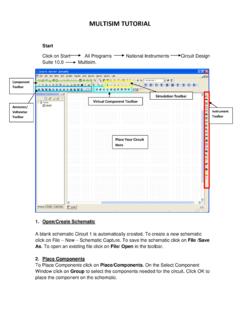Transcription of 0116 - Powered Industrial Truck Manual 11-20 - Michigan
1 Safety Manual for Powered Industrial Truck Operators &. Rough Terrain Truck Operators Consultation Education & Training (CET) Division Michigan Occupational Safety & Health Administration (MIOSHA). Michigan Department of Licensing & Regulatory Affairs (LARA). 517-284-7720. MIOSHA/CET #0116 (Rev. 11/15). Contents: Foreword .. 1. Part I. Powered Industrial Trucks 2. Permits .. 2. Personal Protective Equipment . 2. Safe Operations 3. Know The Rules Of The Road . 4. Checkout Procedures 5. Unsafe To Drive .. 5. Refueling .. 6. Unattended Trucks 6. Elevator Safety . 6.
2 Special Racks .. 7. Loading/Unloading .. 7. Highway Trucks 7. Railway Cars . 7. Slow Moving Vehicles .. 8. Derailer, Bumper Blocks and Clearance Signs . 8. If An Accident Happens .. 8. Protect Your Health . 9. General Safety and Health Guidelines 9. Review . 10. Part II. Rough Terrain Forklift Truck 11. Stability .. 11. Operator Responsibility .. 12. General Information 12. Traveling . 12. Loading 13. Suspended Loads . 13. Elevating Personnel . 14. MIOSHA Advisory 15. Frequently Asked Questions .. 17. Foreword An Industrial Truck operator's job is very important.
3 It is a position of responsibility, the same as when you are driving your car on the road. There are rules and responsibilities you must obey and accept. A Powered Industrial Truck means a mobile, power driven vehicle used to carry, push, pull, lift, stack, or tier material. A rough terrain forklift Truck ( Powered Industrial Truck class 7) means a wheeled-type Truck which is designed primarily as a fork Truck that has a vertical mast or pivoted boom or both, which has variable fixed length reach and which may be equipped with attachments and is intended for operation on unimproved natural terrain as well as the disturbed terrain of construction sites.
4 This Manual is divided into two parts. Part I provides an overview of safety rules and safe work practices for Powered Industrial trucks. Part II provides safety information specific to rough terrain forklift trucks. For specific rules and regulations regarding your responsibilities when driving a Powered Industrial Truck in Michigan , see MIOSHA General Industry Safety Standard Part 21- Powered Industrial Trucks, Construction Safety Standard Part 12 - Scaffolds and Scaffold Platforms, Construction Safety Standard Part 13 - Mobile Equipment. It is important that you read and understand this Manual .
5 Periodic review is suggested to maintain your operating proficiency. 1. Part I. Powered Industrial Trucks PERMITS. You must be trained and tested before you can operate a Powered Industrial Truck . Upon passing this test, and meeting other operator requirements, a permit will be issued to you. It should be carried by you or be available upon request. PERSONAL PROTECTIVE EQUIPMENT. When your employer conducts a personal protective equipment hazard assessment (as required in Part 33, Personal Protective Equipment), they should include Powered Industrial trucks in their review.
6 You should wear approved work shoes. Safety shoes are strongly recommended. Approved eye protection shall be worn at all times. Head protection shall be worn where high-stacking operations are involved. Additional personal protective equipment may be required in a battery charging/changing operation: Chemical splash goggles and face shield Gloves Apron Foot protection Hard hats Eye wash facilities Only authorized employee(s) must change or charge a battery. This should be done only in a designated battery charging area. No smoking or sources of ignition near battery or in battery charging area.
7 When operating a Powered Industrial Truck in a hazardous area, only a Truck specifically equipped for such operation shall be used. 2. SAFE OPERATIONS. No eating, drinking, or smoking while driving. Maintain control of vehicle at all times. No horseplay or stunt driving. You must give right-of-way to emergency vehicles. Keep a clear view of the direction of travel. If the load blocks your view, drive with the load trailing. Operate in designated Powered Industrial Truck routes. Keep aisles clear. Pedestrians have right-of-way. Courteously sound horn or other type of audible device as a warning.
8 Do not approach persons standing in front of bench or fixed object. You should never allow any person to stand or pass under an elevated portion whether loaded or not. Do not overload Truck . No riders, unless the Powered Industrial Truck is designed with a passenger seat. Use the brakes and come to a complete stop: At blind corners. At workplace entrances used by other traffic. Before reversing direction of travel. At designated stop signs. Before entering main aisles or roadways. Always travel at the slowest speed on ramps. No arms or legs between uprights of mast or outside the running lines of Powered Industrial Truck .
9 Never use your Powered Industrial Truck for bulldozing, opening doors, pushing objects or towing vehicles. Do not use tips of forks to push or rearrange stock. Use your Truck for its intended purpose. 3. KNOW THE RULES OF THE ROAD. Keep three Truck lengths behind the Truck you are following. Obey all traffic signs. Never pass another vehicle traveling in the same direction at: intersections, blind spots, or other dangerous areas. Place forks under the load as far as possible to load. Tilt the mast back to cradle the load. You must maintain control over the vehicle at all times.
10 Allow for safe emergency stops. Start, stop, and turn in a way which will prevent a load from shifting or overturning. Keep the forks in the lowest position from the floor when vehicle is moving. Remove loose objects from floors. Don't drive over or around them. Tilt elevated load forward only when directly over unloading area, with load as low as possible. Use special care when placing loads near heaters, electrical connections, pipes, etc. Be careful of the rear end of the Truck swinging around when turning. Be careful near edge of loading docks. Park Powered Industrial Truck in authorized areas only.










